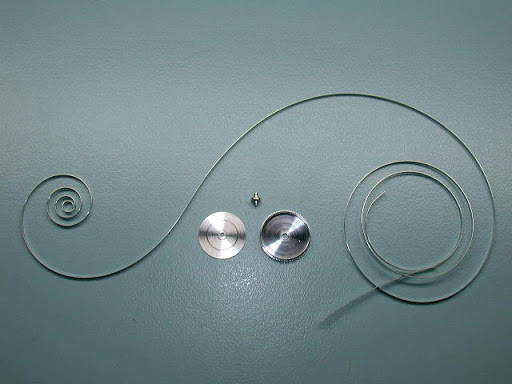A MECHANICAL WATCH IS A THING OF BEAUTY
Even the most modest mechanical watch houses a host of components in what can only be described as miniature feats of engineering excellence and creative daring. Yet one of its most critically important components is also one of its least hailed. That often overlooked component is the mainspring, which is unwarranted given how important it is to any mechanical watch. After all, the ‘magic coil’ that is a mainspring is at the heart of any mechanical watch.
There is a reason why Bloomberg referred to the mainspring as, “Watchmaking’s Most Essential and Underappreciated Component” in a February 2020 article. We here at LIV Watches are so enamored of mechanical watches that we thought it only right to pay homage to this most deserving component. This article will provide some insight into the brief history and basic mechanics of the mainspring. It will also look into some of the maintenance aspects thereof, as well as a few of the typical myths relating to mainsprings.

Keys of various sizes for winding up mainsprings on clocks
THE MAINSPRING: A BRIEF HISTORY
To understand the history of watches, one needs to delve into the history of clocks. It was weights, not mainsprings, that powered the earliest known clocks of Europe. Gravity did all the work to convert the torque needed to drive a clock’s gear train. The actual inventor of the ‘coiled spring’ that is the mainspring as we know it today is unknown. It is thought that the technology was developed from coiled springs first used in medieval locks made by locksmiths. What is known is the world’s oldest existing clock powered by a mainspring, which was a gift given to Philip the Good, Duke of Burgundy, in 1430. The clock is housed today in the Germanisches Nationalmuseum in Nuremberg, a testament to the complexity of timekeeping ingenuity already prevalent in the 15th century.
The sheer complexity of producing a mainspring at that time and in the centuries thereafter cannot be underestimated. The steel needed for a mainspring required very specific properties in order to be crafted into its unique, coiled shape, including its requisite tensile strength. Furthermore, the requisite thinness of the mainspring often proved an even greater challenge for steel-makers of the day. It wouldn’t be an exaggeration to conclude that the mainspring for an 18th century watch could take days of careful, hard labor. This immensely complex technique was described at length in 69 different sections in the book, The Art Of Making Watch Springs (or L’Art de Faire les Ressorts de Montres in its original French) by the English watchmaker, William Blakey, published in 1780.The mass production of mainsprings was only possible almost a century after Blakey’s book was released. The Industrial Revolution had ushered in milling machines that could mass-produce multiple, complex components. Carbon steel mainsprings were an improvement on former steel examples but were still flawed in that they lost elasticity over time. More metallurgically precise alloys emerged after World War II, which resulted in mainsprings that didn’t ‘set’ (lose elasticity) or break so easily. But they were still prone to excessive friction and wear. It was around 1965 that cold-rolled alloys that were less vulnerable to friction and wear replaced carbon steel in mainspring manufacture.

Modern mainspring alloys include Nivaflex, made by the Swiss manufacturer Nivarox, which is owned by the giant Swatch Group. Nivaflex consists of 45% cobalt, 21% nickel, 18% chrome, 5% iron, and 11% other metals. Nivaflex mainsprings have many benefits, including being anti-magnetic.
Crucially important for a mainspring, they also have an extremely high tensile strength of up to 3,000 megapascals and attain values of 800 or greater on the Vickers hardness scale (see representation of the principle below). Just to provide a comparison that any watch enthusiast will appreciate, the 316L stainless steel used in the cases and bracelets of many better watches has a range of between 200 and 240 Vickers in hardness.

"Modern mainsprings are indeed far harder, stronger, and more durable than their carbon steel antecedents. The result is watches that are more durable and should last longer."
 - Esti Chazanow
- Esti ChazanowCo-Founder at LIV Watches

THE MECHANICS OF A MAINSPRING
A mainspring is essentially a flat and thin, coiled blade made of a very flexible steel alloy. It is the ‘energy storehouse’ of the watch. This energy is generated each time the watch is wound, whether automatically or manually, since the curvature of the tightly coiled mainspring is increased, thereby allowing energy to be stored. The coiled shape allows for more even distribution of energy. This stored energy is transmitted to the oscillating section of the watch, known as the balance, via the gear train (or ‘wheel train’) and escapement. It is this fine balancing act between these components and released energy that control the proper timing of the watch.
A mainspring is all about the torque it can generate, being directly proportional to its width and which is why it needs to be so tightly coiled. Hence the reason why a mainspring has a maximum thickness of just 0.00295276 inches (that’s a mere 75/1,000 mm). The thicker the mainspring, the greater its torque, whilst the longer it is, the greater the watch’s running time. However, the snag is that torque is lost with each added millimeter of mainspring. And therein lies the greatest challenge for watchmakers regarding the mainspring: making it long enough to ensure longer running times for a mechanical watch, whilst ensuring that torque remain constant and strong. It’s no easy feat!
Typically, a mainspring is attached to a steel rod (an arbor), which is in turn attached to the crown. This allows the mainspring to be coiled each time the watch is wound. The arbor is held in place by what is called a click while the watch is running. It isn’t the arbor that rotates, but the mainspring barrel in which the mainspring is housed, which has gear teeth that engage the pinions of the gear train (also known as the ‘transmission system’ of a watch).
The gear train primarily comprises the four gears or ‘wheels,’ i.e. the center, third, and fourth wheels, as well as escape wheel and the pallet lever. Each wheel runs at a different speed or, more precisely, each wheel runs more quickly than the one preceding it. The first wheel after the mainspring barrel is the center wheel. It does one one full turn every 12 hours, to which is attached the hour hand. The third wheel is an intermediate wheel and is proceeded by the fourth or seconds wheel, which performs a full turn every 60 seconds and to which is attached the seconds hand. The final wheel, or escape wheel, is technically not part of the gear train but the escapement. Its function is to release energy to the pallet lever.
Bottom line: none of this energy in the gear train and its allied components would be possible without the energy being constantly released from the tightly coiled mainspring.

MAINSPRING MAINTENANCE

Something as thin, tightly wound, and requiring as much tensile integrity as a mainspring could run into problems, even when made with today’s far stronger, highly durable alloys. Since a mainspring is the energy powerhouse of a mechanical watch, so adequate power to or in the mechanism is all-important. Sometimes that intake or release of energy to or from the mainspring will fail for a variety of different reasons.
It’s worth noting that a watch movement may be in excellent condition, yet the watch may nevertheless not work properly simply because the mainspring can no longer deliver maximum energy needed to the gear train. For example, these are some of the signs that a mainspring could be in trouble in a manually-winding mechanical watch:
- The watch simply doesn’t run
- The watch runs slowly
- The watch runs erratically, i.e. fast and then slow, and then fast again, etc.
- The crown turns endlessly

The above could be due a broken or slipping mainspring, or, more specifically, to the mainspring barrel’s hook or arbor hook not catching properly when being wound.
It goes without saying that maintenance of any watch component is best undertaken by a professional. However undertaken, the maintenance of a mainspring should include the following factors:
- The mainspring and its barrel’s diameter, height, thickness, length, and type will need to be known before maintenance can occur. The length will always need to be estimated due to the tightly coiled nature of the spring.
- A thorough cleaning and lubrication with a good-quality mainspring lubricant may be necessary. Importantly, the lubricant or ‘grease’ should be appropriate for the caliber of the watch being serviced. For example, if the grease is too thick then it will prevent the spring from unwinding smoothly inside the barrel. This will result in intervals of irregular power distribution, which will almost certainly affect the performance of the watch.
- Some of the most common greases used in the cleaning and maintenance of mainsprings, including the inside of the barrel, are Moebius 8217 natural grease, 8141 natural oil, and D-5 microgliss.
Some watch experts believe that the best form of mainspring maintenance is to simply replace it each time the watch is serviced, given that mainsprings are relatively inexpensive and simple to replace. This is also the consensus in online watch repair forums. Also, expensive mainspring winders won’t be needed when fitting a new mainspring. This saves a substantial amount of money because these tools are expensive. Furthermore, time and potential mishaps are avoided since a new mainspring means not having to clean, lubricate, and re-fit an existing mainspring.

MAINSPRING MYTHS
Mainsprings may be razor-thin, tiny and tightly-coiled, but they’re not exactly fragile either. Nor are they made of porcelain (!) - remember, mainsprings are precisely made to be tough, durable, and flexible. This ‘fragility’ myth is just one of the factors that feeds the many myths that surround mainsprings. Here are just four of those myths:
1 • Watch winders are essential for vintage watches: Incorrect.
This myth results from the logic that self-winding or automatic movements benefit from being in constant motion, hence the need for winders. In fact, watch winders can be particularly problematic for vintage watches. The constant winding may put undue wear on the winding system of the watch, and it can also dry out the mainspring’s lubrication more quickly.
2 • It’s best to leave an old mainspring in for the ‘integrity of the movement: Incorrect.
As already explained above in the maintenance section, the replacement of a mainspring is usually the best solution when doing cleaning or maintenance on a watch movement. ‘Integrity’ of a movement is itself a myth of sorts. Like any mechanical device, a movement will invariably require replacement of certain of its parts during its lifetime. Ask any car collector about that! The same goes for watches.
3 • Replacement of a mainspring will devalue a vintage watch: Incorrect.
See point 2 above. Any watch expert will confirm that assessing the exact ‘provenance’ of a movement is far more difficult than one would think. And nor does replacing a mainspring in any way devalue the worth of a good watch.
4 • You must be careful not to wind a mechanical watch too much: Incorrect.
This is actually one of the most enduring myths of all regarding mechanical watches and, by extension, mainsprings. Watch experts will categorically state that ‘over-winding’ of a decent-quality modern mechanical watch is not actually possible. The winding mechanism of a mechanical watch, whether manual or automatic, simply ‘decouples’ from the mainspring when it is fully wound. It can literally be wound to infinity thereafter without any damage to the mainspring.
There is an important caveat however: an old or poor quality watch can result in a damaged mainspring if over-wound. So keep that in mind when winding your vintage or inexpensive mechanical watch!

IN CONCLUSION
Perhaps now one can better appreciate why we thought it necessary to dedicate an entire article to a tiny, coiled piece of metal found in any mechanical watch. Think of it as ‘the little engine that could,’ and without which a mechanical watch is no more.


